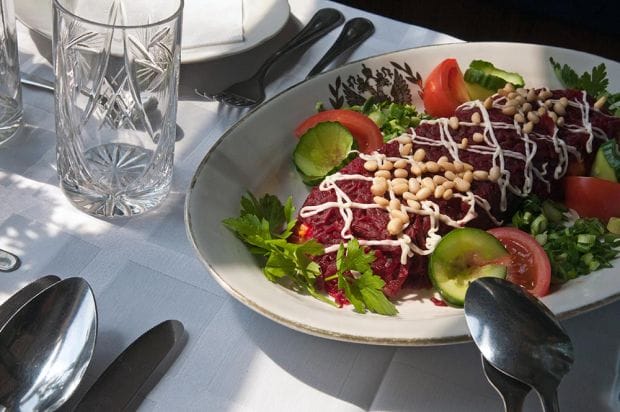I’ve had Siberian Express dreams for years, taking a train across the vast stretch of Siberia, leaving Moscow headed constantly on, day and night, to distant places in Asia. December 2014 was our opportunity to make dreams real. With eight nights and seven days on board, we had to eat.
Eating aboard the trains wasn’t our first concern.
Dining cars are generally available (more on this later) but many of the passengers, especially the Russians and younger Europeans on a tight budget, brought their own provisions. The coal-fired samovar at the end of each car was tended by the provinista for that car and served as a constant source of hot, potable water. Tea bags, instant coffee, and dried noodle packages lined the tables in many of the cabins along with spoons, forks and an assortment of bowls and cups.
At most stops, passengers would jump off the train for a quick smoke (absolutely forbidden on the train) and a run to the trackside shops to replenish their ramen supply and maybe purchase some soft drinks or bottled water. At these stops, even as late as 11:00 on a cold Siberian night independent vendors would also stand by the train doors holding up homemade sausages, dried meats, smoked fish and other substantial foods. And, our provinistas could usually be counted on to have a cache of candy bars, chips, and ramen. Supply, demand, and overhead factored into the pricing. The cheapest tended to be the independent vendors who did not compete directly with the shops. The shops were in the middle of the pricing system, and the provinistas were the most dear, but often the only choice. The provinistas would gladly brew tea or coffee for those of us without cups or tea bags, charging only 30 cents US per cup.
The trains were either Russian or Chinese. However, within the country we were traveling, the dining cars were from that country. So, as we crossed Russia in a Russian train, we had a Russian dining car. Our second class train from Ulan Bator to the Chinese border had a Mongolian dining car. (There was no dining car on the first part of the Mongolian trip from the Russian border to Ulan Bator as we entered after midnight and arrived at 5:40 in the morning.) Our train to Beijing changed out not only wheels but dining cars, and we had a Chinese version then.
Without bags of provisions and utensils we walked through the train to the dining car for our meals, but we had planned to do so anyway. On our first morning we made an important discovery. The cook and waitress slept on the floor or tables during the night. We walked in to find both of them sound asleep, the cook on a table, the waitress on the floor. We tip-toed out and returned an hour later. The same happened on our second train, but they were bedded down on the floor towards the other end, so we sat down and quietly read until they stirred.
The menus were sometimes illustrated and always in at least two languages, English being the default second tongue. But being listed on the menu did not mean the dish was available to order. In fact, with so few people in the dining cars—we often dined alone—I was surprised that we had any choices instead of simply “today’s plate.” The offerings tended toward the bland and while not memorable, they weren’t bad either. Certainly they were reasonably priced, and this was also where a varied supply of cold beer could be found along with bottles of wine in some dining cars. We had a serviceable bottle of Bordeaux in the Mongolian diner for about $8 US.
The Russian dining car favored dark red and gold with drapes and complementary booths for four. The Chinese car was also red, but more sleek (or stark) and the help often took over a booth to total the receipts and complete paperwork. The Mongolian dining car was a delight of hand-carved wood, paintings, and a few antique artifacts.
The only glitch: we sat for seven hours on a siding in Mongolia. I stepped off the train once, looking up and down the track. All that was there was our car and the dining car. Later we felt a jerk and assumed they were adding more cars, putting together the train for the next haul. We decided to stroll down to the dining car for lunch and maybe a beer. We walked down the aisle, though the door to the connecting section, and stood stunned. The dining car was gone. It was just us, one solitary train car, stuck on a siding somewhere in Mongolia. Several hours later other cars, including the diner, were attached and we were moving again.
– Gary Gray




